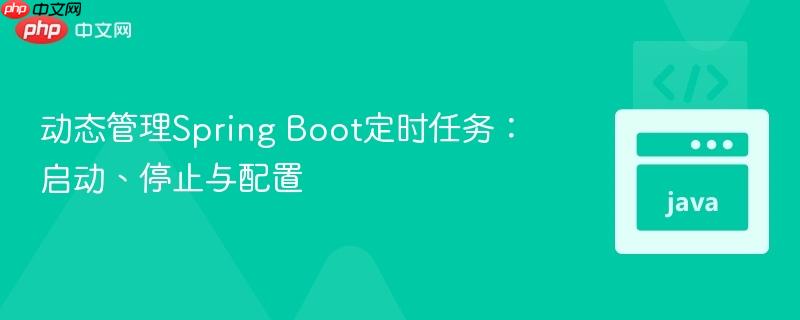
本文旨在提供一种动态管理Spring Boot定时任务的方案,允许在运行时根据客户端需求启动和停止任务。通过维护一个简单的标志位,控制任务是否执行,避免了频繁创建和销毁定时任务带来的复杂性。这种方法尤其适用于任务逻辑相同,但执行时机或是否执行取决于客户端配置的场景。
在实际应用中,我们经常需要根据外部条件动态地启动或停止定时任务。例如,根据用户的订阅状态、系统配置或数据库中的数据来决定是否执行某个任务。Spring Boot 提供了强大的定时任务支持,结合一些技巧,可以实现灵活的动态管理。
核心思想:利用标志位控制任务执行
不同于动态创建和销毁定时任务,本文介绍一种更简单的方法:维持任务的持续运行,但通过一个标志位来控制任务内部的逻辑是否执行。这种方法避免了管理 ScheduledFuture 的复杂性,尤其是在任务数量较多时,可以简化代码和提高可维护性。
实现步骤:
import org.springframework.stereotype.Service;
import java.util.concurrent.ConcurrentHashMap;
@Service
public class MyFlagService {
private final ConcurrentHashMap<String, Boolean> clientSchedulerFlags = new ConcurrentHashMap<>();
public void enableScheduler(String clientId) {
clientSchedulerFlags.put(clientId, true);
}
public void disableScheduler(String clientId) {
clientSchedulerFlags.put(clientId, false);
}
public boolean isSchedulerEnabled(String clientId) {
return clientSchedulerFlags.getOrDefault(clientId, false);
}
}import org.springframework.beans.factory.annotation.Autowired;
import org.springframework.http.HttpStatus;
import org.springframework.http.ResponseEntity;
import org.springframework.web.bind.annotation.RequestMapping;
import org.springframework.web.bind.annotation.RequestParam;
import org.springframework.web.bind.annotation.RestController;
@RestController
class SchedulerController {
@Autowired
MyFlagService myFlagService;
@RequestMapping("start")
ResponseEntity<Void> start(@RequestParam String clientId) {
myFlagService.enableScheduler(clientId);
return new ResponseEntity<>(HttpStatus.OK);
}
@RequestMapping("stop")
ResponseEntity<Void> stop(@RequestParam String clientId) {
myFlagService.disableScheduler(clientId);
return new ResponseEntity<>(HttpStatus.OK);
}
}import org.springframework.beans.factory.annotation.Autowired;
import org.springframework.scheduling.annotation.Scheduled;
import org.springframework.stereotype.Component;
@Component
public class MyScheduledTask {
@Autowired
MyFlagService myFlagService;
@Scheduled(fixedDelay = 5000) // 每5秒执行一次
public void myWorkerFunction() {
// 假设clientId 从某个地方获取,例如数据库或者配置
String clientId = "clientA"; // 示例clientId
if (!myFlagService.isSchedulerEnabled(clientId)) {
return;
}
// 执行实际的任务逻辑
System.out.println("Task executed for client: " + clientId);
// ... 其他业务逻辑 ...
}
}代码解释:
注意事项:
总结:
通过维护一个简单的标志位,我们可以实现动态地启动和停止 Spring Boot 定时任务。这种方法简单易懂,易于维护,并且可以有效地管理大量的定时任务。 这种方案避免了直接操作 ScheduledFuture 的复杂性,更适用于需要根据客户端配置动态控制任务执行的场景。 关键在于 MyFlagService 的设计,它充当了配置和任务之间的桥梁,使得我们可以灵活地控制任务的行为。
以上就是动态管理Spring Boot定时任务:启动、停止与配置的详细内容,更多请关注php中文网其它相关文章!

每个人都需要一台速度更快、更稳定的 PC。随着时间的推移,垃圾文件、旧注册表数据和不必要的后台进程会占用资源并降低性能。幸运的是,许多工具可以让 Windows 保持平稳运行。

Copyright 2014-2025 https://www.php.cn/ All Rights Reserved | php.cn | 湘ICP备2023035733号